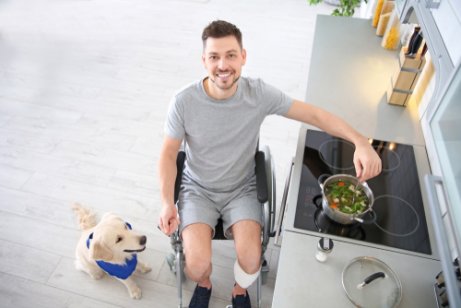Can You Give Soup To Your Dog?


Written and verified by the lawyer Francisco María García
Although dogs don’t have problems eating the same food every day, some owners decide to change their food every once in a while. For example, you can give soup to your dog as a nice tasty surprise or if they need special food due to health reasons.
It’s always better to cook these meals from scratch than using canned or packaged products. Almost all packaged foods contain chemicals that are harmful to animals.
Salt: enemy number one
Before you give soup to your dog, you should know what ingredients not to put in the meal. The most dangerous ingredient that you shouldn’t give to your dog is salt.
Although dogs can tolerate minimal amounts of salt, a larger amount can cause moderate to severe poisoning. Vomiting, diarrhea, and loss of appetite are some of the symptoms. However, there are more serious cases that can cause kidney damage, seizures, and even death.
Onion and garlic are other ingredients that shouldn’t be added to your dog’s soup. These ingredients destroy their red blood cells, which can lead to hemolytic anemia. There is also a risk of producing gastroenteritis in dogs.

Give soup to a dog that needs it
Just like humans, sometimes you need to give soup to your dog because he is having some sort of health issue. This is the case with colds, digestive problems, vomiting, diarrhea, or difficulties chewing or eating solid foods.
The winter flu also affects dogs. Therefore, chicken noodle soup could be a good alternative to dog food. Also, this soup is good when your dog is having digestive issues.
Soups can complement commercial dog food are great for dogs that are having stomach problems or require a soft diet. This combination, in addition to alleviating the condition, will prevent the animal from becoming dehydrated.
Can you feed your dog only homemade food?
While it’s possible to only feed your dog homemade food, there are some basic considerations to think about. Except in certain cases, dogs need to eat solid food. A menu that only includes soup is unacceptable unless a veterinarian indicates otherwise.
Store-bought dog food ensures that dogs eat a balanced diet with all the proteins and nutrients they need. An “alternative” homemade diet should follow this same principle.

Chicken and carrot soup
The following recipe, in addition to being easy to prepare, contains beta-carotene and vitamins A, E, and B. It also has calcium, potassium, phosphorus, and iodine. Plus, it contains fats, calories, and all special amino acids.
This type of soup is recommended for all dogs, especially those that exercise on a daily basis with their owners. It’s also suggested for dogs that have problems with malnutrition or with their skin or fur.
Ingredients:
- 250 grams of chicken giblets, cut into very small pieces (sweetbreads, hearts, livers)
- Two large carrots
Instructions:
- Wash, peel, and cut the carrots.
- Put all ingredients into a pot of boiling water and cook for 15 minutes. Let the soup cool before serving.
- Don’t go overboard with serving sizes. A normal bowl should be enough.
- You can optionally add some normal dog food when serving.
- This soup can be refrigerated for up to three days.
- Remember: you should not add any kind of salt or spices.
Rice Soup
This soup is good for dogs that have diarrhea. Rice is a grain which helps restore your dog’s appetite in addition to providing calories, vitamin E, phosphorus, and potassium.
Ingredients:
- 2 cups of rice
- 250 grames of boneless and skinless chicken or lean beef
Instructions:
- Cook the rice in five cups of water.
- Chop the chicken or beef into very thin slices and boil in four cups of water until well cooked.
- Add the rice and heat for 5 minutes.
- Let it cool until it’s warm before serving.
This text is provided for informational purposes only and does not replace consultation with a professional. If in doubt, consult your specialist.